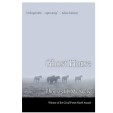One of my reviewing regrets of late is my delay in highly recommending Thomas H. McNeely’s powerful and moving coming-of-age novel Ghost Horse (winner of the Gival Press Novel Award).
The setting is mid-seventies Houston, and the central character is Buddy Turner, who at the start of the novel is leaving Queen of Peace, a largely Latino school in one part of the city, for an all-white school in another. The schools seem worlds apart given the racial divide between them, and in the city at large. We sense this divide from the very beginning of the novel, when Buddy and his good friend Alex Torres make their way from Buddy’s last day at Queen of Peace to Alex’s home.
Central to the bond between Alex and Buddy is a Super-8 movie that they are creating about the Ghost Horse of the novel’s title. According to the storyline that the boys work out together, a horse perishes in a local swamp, only to be resurrected by a bolt of lightning and transformed into the winged Ghost Horse, rescuer of the imperiled. Alex, a skilled artist, has taken on the job of creating frame-by-frame drawings of the horse, which will be used to animate the movie. Working alongside Alex, Buddy writes the script.
But progress on the movie—and, more important, the bond between Buddy and Alex—begins to falter once Buddy moves on to his new school, St. Edward’s, where friendship with a Latino proves a source of shame. There, Buddy is drawn to Simon Quine, the ringleader of a cruel pack of boys, and an imposing figure in his own right.
When Buddy first meets Simon, it’s clear that Simon knows more about him than Buddy had supposed.
No one at St. Edward’s knew about Queen of Peace, Buddy thought, except for Mrs. Gray [a teacher at St. Edward’s]. He felt as if Simon had reached out and touched his bare skin. … “How do you know?” Buddy said.
Simon only grinned. “That’s where spics go, isn’t it?”
It was the word his mother had told him never to use. When one of the white boys at Queen of Peace called him a spic, Alex had broken his nose.
“Sure,” Buddy said.
As this scene and later ones make clear, secrets about other boys are, for Simon, a sort of currency, a source of power based on shame. Simon’s fascination with secrets is especially terrifying for Buddy, who has been burdened with plenty of them by his own family—especially by his father, Jimmy, who left Buddy and his mother for a time but wants to return to them and make the family whole again. Jimmy warns Buddy that a lasting reunion will be possible only if Buddy keeps the most painful secret of all.
As Buddy soon discovers, Simon carries family secrets of his own, the pain and shame of which seem to drive Simon’s cruelty to others and, eventually, give Buddy a special influence over him, also exercised through cruelty. McNeely’s thoughtful exploration of the powers and burdens of secrets makes this coming-of-age story especially rich and illuminating, and also heart-rending. When Alex re-enters the picture and meets Simon, the power dynamics shift again, with painful consequences that McNeely portrays vividly.
As McNeely commented in an interview with The Rumpus, “What creates the savagery of childhood is, of course, adults’ abuse, spread through children. I think that’s why coming of age novels endure, and will always be relevant, because we look back at that gauntlet we ran through our own childhoods, through conflicts which are never truly resolved, and yet we can view them as if they are foreign. Maybe this is why writers find this territory so fertile—its strangeness and familiarity creates its own world, like fiction itself.”
For me, one of the most fascinating and moving aspects of the novel is its investigation of the powers—and limitations—of creativity. On the one hand, the Ghost Horse that Alex and Buddy create is a tragic figure: he’s imagined as a rescuer but is never fully realized, much less heroic. Even Buddy sometimes thinks of the Ghost Horse as a “lie,” something “only a child would believe.” On the other hand, the horse is a real and powerful force of the boys’ imaginations. This made me think more generally about the human drive to imagine and create. Sometimes, this drive seems powerless—even irrelevant—in the face of the “real” trials of our lives. Other times, it feels like the one of the few things that can sustain us and lift us, however temporarily, over the perils of the real. This novel brought that feeling home for me, once again.
Would My Pick be Your Pick?
If you're interested in ________, the answer may be "Yes":▪ The Member of the Wedding by Carson McCullers
▪ The Catcher in the Rye by J.D. Salinger
▪ The works of Flannery O’Connor, especially The Violent Bear It Away
▪ Cormac McCarthy’s novels






